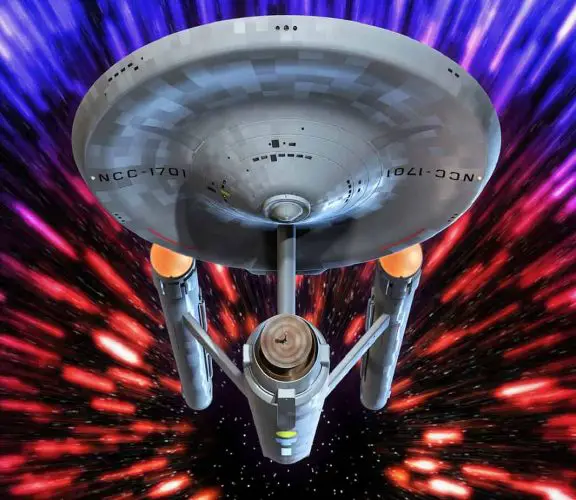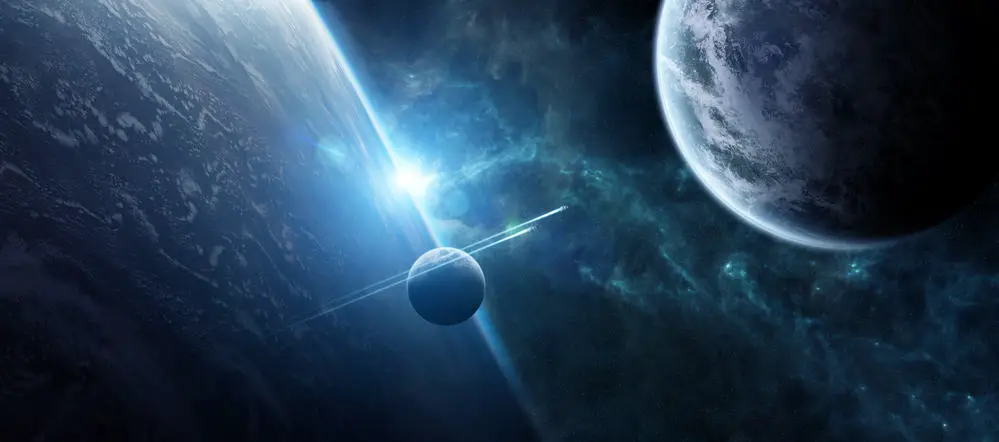You’re buzzing along in the Millenium Falcon, ridin’ dirty, and an Imperial Cruiser pops up out of nowhere. Or, you’re skimming the asteroid belt in the Starship Enterprise when a Klingon starship fires a disruptor blast across your bow. You need to make an incredibly fast getaway, but what’s the best technology to use?
Hyperspace or Warp Drive – which is faster? Hyperspace is faster. It’s faster because the pilots in the Star Wars series discovered an alternate dimension that allows travel at several times the speed of light. Warp drive also allows speeds greater than the speed of light, but not to the extent of hyperspace.
It’s not rocket science. It’s physics. OK, fictional physics. There is no such thing as hyperspace or warp drive, but the pseudo-theories offer many intriguing thoughts for space junkies everywhere. Where does science fiction and science reality meet in the Star Wars and Star Trek series?

It’s Not My Fault
Pursued by an Imperial Destroyer in Empire Strikes Back, Han Solo prepares the Millenium Falcon for a jump into “lightspeed” (slang for hyperspace). His hairy pal Chewbacca flips a couple of switches, Princess Leia and C3PO hold on to something sturdy, and Solo rips back the throttle.
Nothing. Zilch. Nada.
“It’s not fair,” Solo says, scanning the console in front of him. “The laser circuits are working. It’s not my fault!”
– Han Solo, Star Wars
Tricky stuff, this hyperspace technology. Get one thing wrong and kaflooey! That’s because hyperspace isn’t exactly moving from Point A to Point B, but moving from one dimension to another. In Star Wars, hyperspace isn’t a speed but a place – a place where both distance and time are compressed. To enter hyperspace, you must already be traveling at superluminal (faster than light) speeds, which wasn’t happening in that scene, due to a malfunction.
Hyperspace Next Exit

You don’t just accelerate up to hyperspace gradually. You jump or leap into it. One minute you and your space ship are abiding by the laws of physics as you’ve always known them to be, and the next millisecond you’re in a realm where those laws don’t apply.
It’s a totally different world, where life forms, machines, planets, stars, and broken bits thereof position themselves in perfect spatial relationship to each other, but not to space itself. In hyperspace, molecules are displaced, sort of like they are in the transporting concept introduced in Star Trek (“Beam me up, Scotty.”), but with properties that behave in ways not seen on this side of the hyperspace perimeter.
In a realm where the rules are crazy different, you still have to follow the rules. There are specific routes that you must follow through hyperspace to make sure that you and all the molecules traveling with your arrival at the right place when you exit this galactical super highway.
- Traveling through hyperspace
ain’t like dusting crops, boy. Without precise calculations, we
could fly right through a star or bounce too close to a supernova,
and that’d end your trip real quick, wouldn’t it? – Han Solo
to
Luke Skywalker
186,000 Miles Per Second – Mere Child’s Play
Before taking the on-ramp to the hyperspace freeway, you have to already be traveling at or slightly above the speed of light. If you live in Han Solo’s galaxy, that’s not a problem, usually. For starters – literally – you need Hyperdrive 3.0 or higher.
Hyperdrives manipulate hyper matter (fuel) particles to help the engine accelerate the spaceship to the speed of light. This is a physical, actual, real-time, Point A to Point B event that prepares the ship for the leap to hyperspace. This is often unsettling to unsecured molecules (not to mention inexperienced pilots), but when the parameters are properly set, everything stays intact.
Hyperdrive engines do the actual work of moving the spacecraft through space, and they are the real workhorses in the process. Without a good hyperdrive engine, you’ll never even get to the celestial door of hyperspace, regardless of what fancy programming software you have onboard.
The evil empire was fond of using interdictor vessels to sabotage the hyperdrive engines of rebel spaceships, preventing them from escaping into hyperspace.
Please Consult Your Hyperspace User’s Manual

Think of hyperspace as a mirror website, where all the pixels in the original website can be found in the same relationship to one another at a different address on the web. Only, instead of a web-based location, it’s a real (tongue firmly in cheek here) location. Every object has a mirror image in hyperspace, also known as a shadow.
And, as we’ve already established, the points (molecules) behave differently in hyperspace, adhering to nothing that might otherwise constrict or constrain them on the other side. It’s a cosmic free-for-all, and those who aren’t careful can pay a high price.
Visual flight rules, as you might apply them to space travel, don’t apply in hyperspace. You can’t go by what you see. Since you are traveling through a realm where mass and energy are rolling around like marbles on a tabletop, you have to make precise calculations and stay on the “routes” through the realm.
You’re safe while in hyperspace, but watch out for the exits. You can exit hyperspace right into a planet or star whose shadow was invisible to you while you were in hyperspace.
Hyperspace Incidents in Star Wars
- Millennium Falcon encounters shattered bits from the planet Alderaan.
- Cruiser carrying Anakin Skywalker makes the risky jump to hyperspace.
- Jyn Erso used hyperspace to escape the destruction of the Holy City on Jedha.
- Herra Syndulla out-maneuvered an imperial ship using hyperspace.
That’s No Moon
With
The first thought was that Solo had miscalculated their coordinates and that they had ended up in an asteroid field instead of hovering over the earth-like planet Alderaan. Solo double-checked his computers, and realized that everything had been programmed properly for hyperspace travel, so what gives?
The only explanation for all the rocks and debris was that the planet had been violently destroyed. It turns out that it indeed had been destroyed by a brutally powerful laser beam fired from the pride of the empire – The Death Star – as a demonstration to let the rebel fleet know just what they were dealing with.
As Obi-Wan calmly announced, “That’s no moon.”
The Kessel Run in Less Than 12 Parsecs
Han Solo’s famous brag that the “Millenium Falcon made the Kessel Run in less than 12 parsecs is often misunderstood. Many people assume that a parsec is a measure of time, like some division of a second, perhaps, but a parsec is a measure of distance. A rough definition of a parsec is to describe it as scientific notation for distance. The Kessel Run was an 18-parsec route taken by spice smugglers hoping to outrun Imperial cruisers.
So when Solo says the Falcon made the Kessel Run in less than 12 parsecs, he’s either saying that he somehow shortened the route by six parsecs or that he was simply throwing smoke at Ben Kenobi, with whom he was negotiating a transport deal.
A third possibility was that George Lucas made a mistake when writing the script for the movie.
The Term Hyperspace Didn’t Begin With Star Wars
The fictional concept of hyperspace started showing up in science fiction literature early in the 20th century, although accounts of space travel go back as early as 1634, with the publication of Somnium by Johannes Kepler, the account of a moon voyage.
Arthur C. Clarke brought up the subject of hyperspace in his novel Technical Error (1950), yet in his sci-fi classic 2001: A Space Odyssey (1968), he describes a manned flight to Saturn at clearly subluminal speeds, with travelers subjected to suspended animation to account for the lengthy journey.
Many works of science fiction speak of the dangers of hyperspace travel, such as emerging from hyperspace too close to a celestial object with a strong gravitational pull. In some books and stories, achieving hyperspace is easy and routine, while in others, it requires massive expenditures of energy and technology.
As a literary device for sci-fi writers, hyperspace is often deliberately kept mysterious and aloof to add drama and intrigue to a story. If it becomes too commonplace, the reader’s imagination is not engaged.
Warp Drive. Second-Fastest is Still Fast
For a spaceship propulsion system that doesn’t exist, warp drive is pretty cool. You’ll find warp drive references in Star Trek and in works by science fiction author Isaac Asimov.
A spaceship boasting a warp drive can travel at speeds greater than the speed of light. Unlike hyperspace, warp drive travel is linear and is carried out in the present dimension with no instantaneous travel between two points. Visible obstacles in the spaceship’s path will be struck unless the spaceship diverts its course.
The warp drive concept presumes to disprove Einstein’s Theory of Relativity, which states that objects cannot move at the speed of light because of the infinite amount of kinetic energy that would be required. But the warp drive theory suggests is that if the object can’t be brought through space at the speed of light, space can be compressed (warped) to shorten the distance between two points. Therefore, the time to get from place to place is reduced greatly.
So when Captain Kirk orders, “Ahead warp factor one,” he is requesting that space be compressed by a preset amount, so that The Enterprise can zip out of a dicey situation and not be followed. What warp factors two, three, four, etc., mean in relationship to warp factor one is arbitrary. It’s a bogus theory anyway, so mathematical symmetry is not necessary.
Just When You Learn the Rules, They Change Them
The scale for warp factors in the original Star Trek series was modified in the Star Trek: The Next Generation series. There, some sort of mathematical symmetry was attempted. The intervals between factors were tightened up, and warp 10 was established as the unattainable maximum, requiring simply too much kinetic energy to pull off.
This maximum was titled “Eugene’s Limit” in homage to Gene Roddenberry, the original series producer.
Variations of the Warp Drive Concept
- Warp Velocities – the relative speed of an object moving through space as it applies to the warp theory.
- Transwarp – Speeds and capabilities that are beyond conventional warp drives.
- Quantum Slipstream – A narrow tunnel through which spaceships can travel at superluminal speeds.
- Folding Space – Two points of space/time are directly connected, and the space in between collapses.
- Slingshot Effect – Using a celestial body that has great mass to slingshot a spaceship to a different time.
Without the Warp Drive, We Might Never Have Met Mr. Spock
The first warp drive was built in 2063 on planet Earth by Zefram Cochrane, who discovered what he called the space warp. He is celebrated as a great inventor several times in the original Star Trek series, but there was one problem with that title – other species in the universe already had versions of the warp drive.
One of those species was the Vulcans. As it turns out, the Vulcans had been watching earthlings for over 100 years. When humans launched its first satellite into space – Sputnik I – in 1957, Vulcans were on the edge of earth’s atmosphere, watching. Later, that Vulcan vessel crash-landed near Carbon Creek, PA, marooning several crew members. They blended in with the local residents – keeping their pointy ears covered, one can assume – until they were rescued.
During Cochrane’s test-run of his warp drive, humans and Vulcans actually met face-to-face. The Vulcans followed Cochrane’s ship, the Phoenix until it landed near Bozeman, MT. This day – April 5, 2063 – is known as First Contact Day. Needless to say, the meeting was peaceful and beneficial to both sides.
It was the union between a Vulcan (Sarek) and a human (Amanda Grayson) that gave us Spock. No first name. Just Spock, later designated as Mr. Spock, who taught the people of earth – real and fictional – what it means to be logical and the four-fingered Vulcan salute.
Before there was the DeLorean, There was the Enterprise
Ya mess around with a warp drive, and the next thing you know, it’s yesterday. Or last week. Or next week. Forty-nine times in the Star Trek series – including all the more recent iterations – the Enterprise found itself in another time and another place.
Sometimes, it was intentional. Sometimes it was accidental. Sometimes returning to the present was as easy as flipping a few switches, and sometimes it took the whole episode to fix things right. Not all of the time travel episodes involved a warp drive, but the time travel concept can be seen as a spin-off to the idea of compressing and shifting time and space.
Other Fictional Technologies in Star Wars and Star Trek
Science fiction should often be called tech fiction because it introduces technology that is not yet available in real life or will never be available in real life. These technological advances in movies like Star Wars and Star Trek can be momentary diversions of the imagination, or they can create significant plot points upon which an entire story rests.
Tractor Beam
A tractor beam used a gravity-like force field to bring objects to its base. Its most common application was in the various spaceports and docking stations in Star Wars, where ships can be safely guided in through narrow portals.
In Star Wars: A New Hope, the Millenium Falcon was subjected to the Death Star’s tractor beam when the passengers on board didn’t want it to be. Obi-Wan Kenobi, at great risk, found the control unit for the tractor beam and disabled it so that the Falcon could escape.
Transporter
Perhaps the most famous science fiction device ever, Star Trek’s transporter, provided a sense of wonder for viewers and even created some catch phrases that are in abundant use throughout society.
A transporter converts a person into an energy pattern and then transmits it to a target for reassembly (rematerialization) at the destination. If all goes well, the transported person or thing is put back together in perfect order. But, things can go wrong, and a person can get trapped in the energy field phase and, like Humpty Dumpty, are never able to be put back together again.
Force Field (Deflector Shield)
Spaceships, space stations, and entire planets can be protected from bombardment by invisible energy shields. These devices deflect incoming laser strikes, missiles, pods and anything that comes against them. They can also go mobile, protecting a spaceship from attack and from collisions with space debris.
Entire fleets can be protected by a force field, as we saw in Return of the Jedi. A crucial point in the storyline involved the disabling of the Empire’s force field generator on the planet Endor.
A force field is not an entirely fictional effect. In 2015, Boeing created a weak (in comparison to the Star Wars and Star Trek models) force field using plasma energy to offer protection to aircraft against the force of an explosion. It cannot deflect solid objects, however, and the overall application of the technology is beset by a number of practical issues.
Cloning
Cloning and genetic engineering in both Star Wars and Star Trek are light years ahead of the real thing, and we earthlings may never reach the levels seen in the movies. The cloning in Star Wars is so advanced that even human conduct can be programmed through mutation of DNA and manipulation of growth hormones.





Leave a comment
You must be logged in to post a comment.